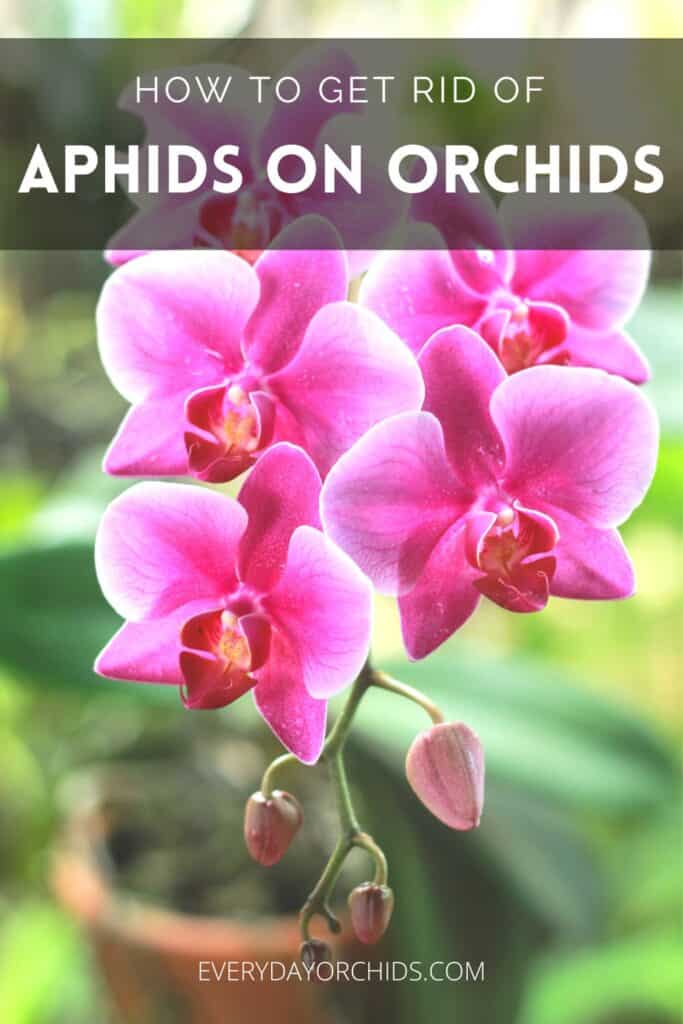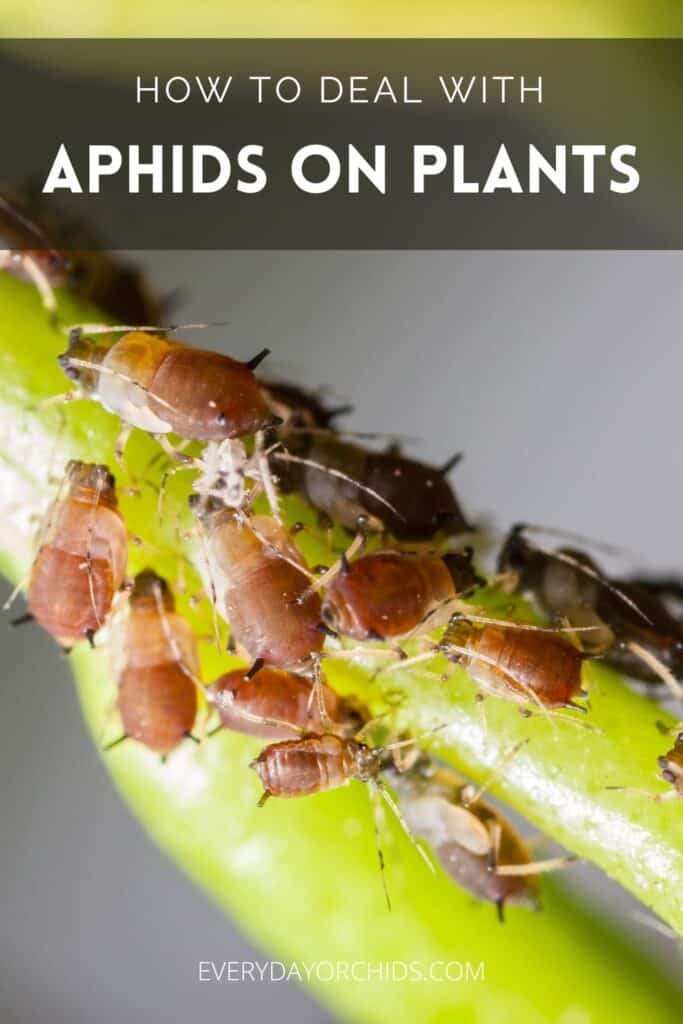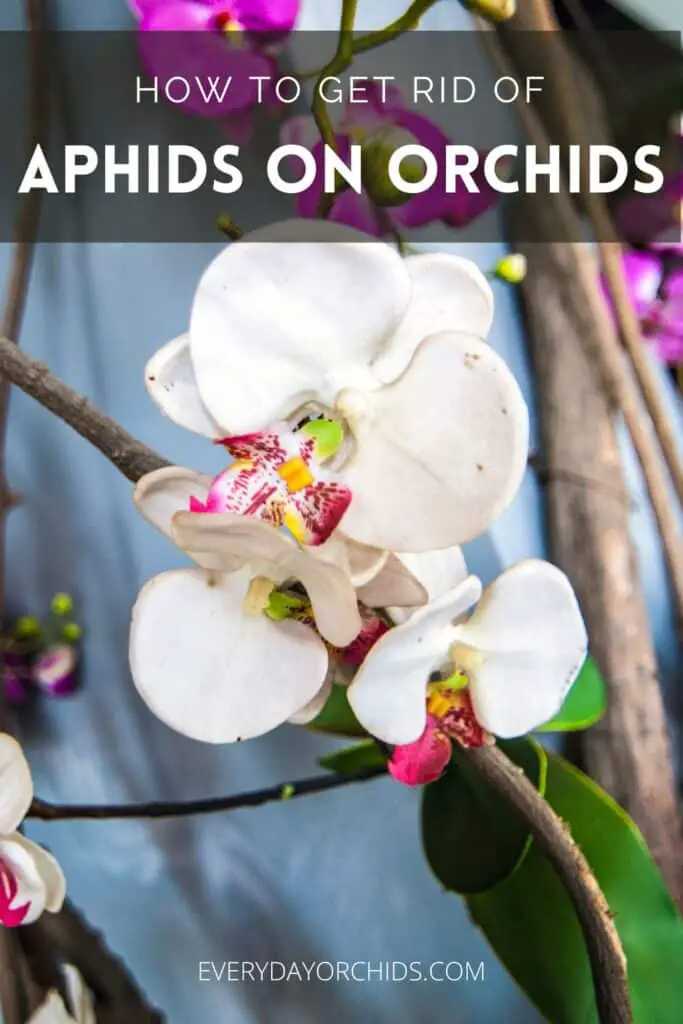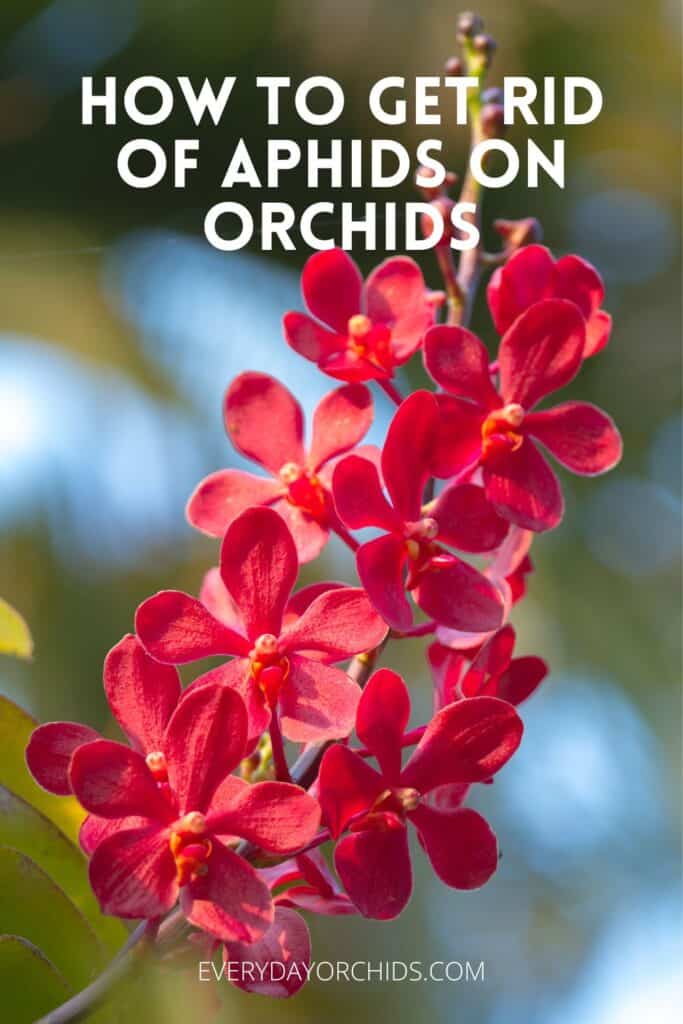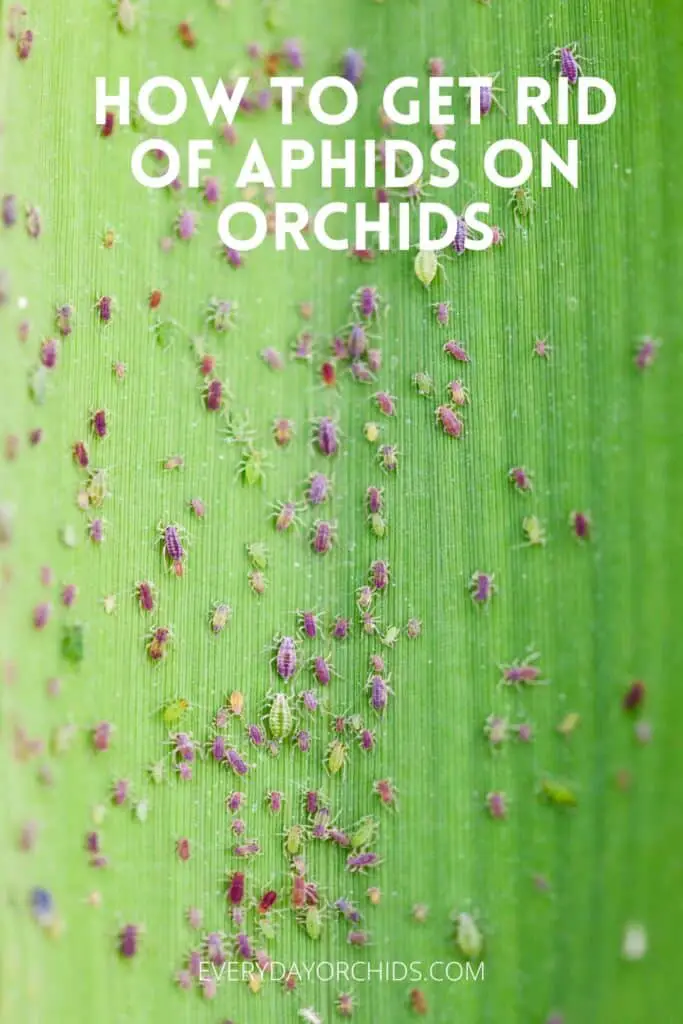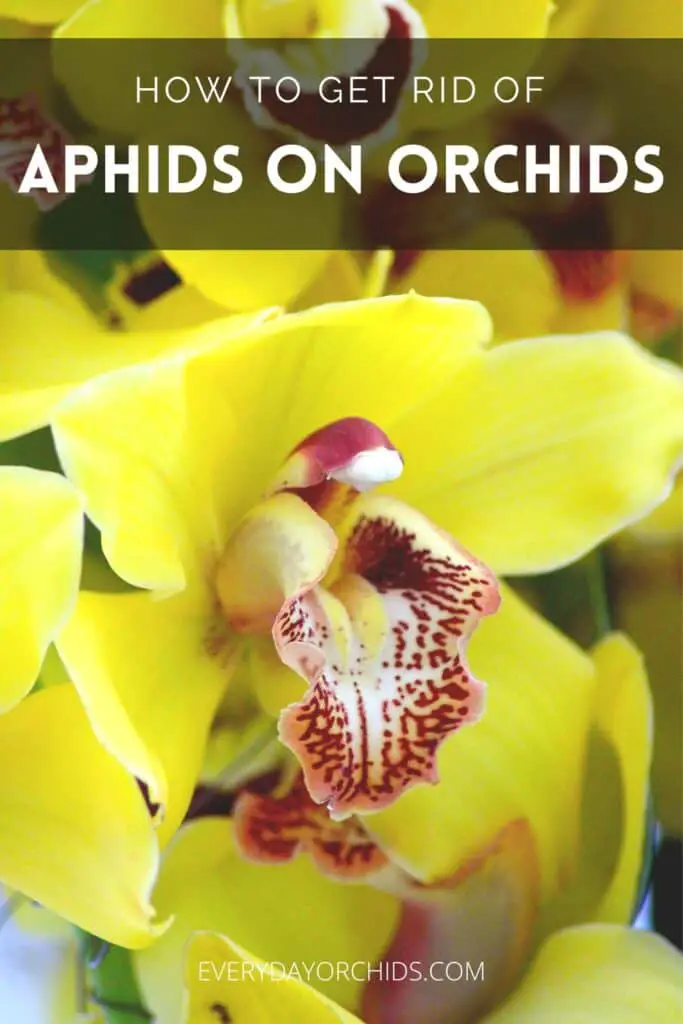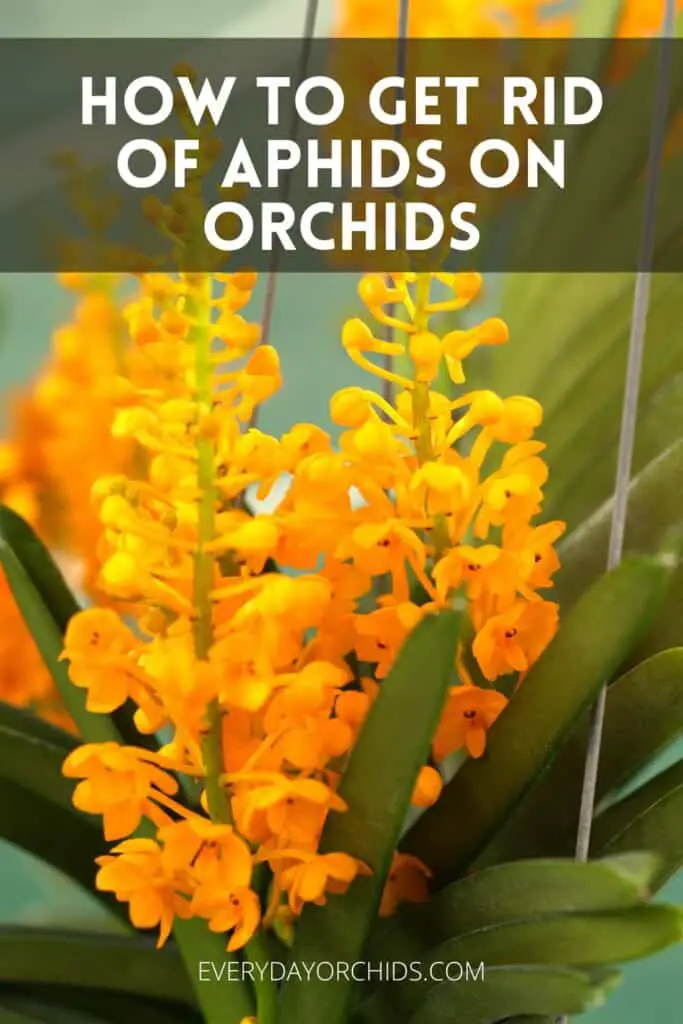Got aphids on your orchids? Don’t stress, you aren’t the only one. Aphids are one of the most common orchid pests out there. If you notice aphids on your orchids, you’ll need to take some steps to get rid of them and keep them from coming back. If left alone, aphids can do a lot of damage to your orchid, so time is of the essence when dealing with an aphid infestation.
Aphids on orchids can be eradicated using a variety of methods, including manual removal with rubbing alcohol, using horticultural oils, or spraying with insecticidal soap or insecticides. Aphids multiply quickly so immediate action is necessary when you notice aphids on your orchids.
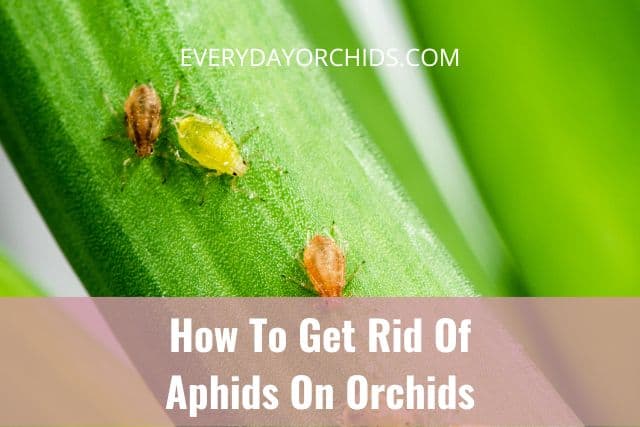
In this article, I’ll talk about how to spot aphids on orchids and why it is so important to address the problem immediately. You’ll learn about some treatment options and ways to get rid of aphids on orchids. I’ll also give you some tips on how to prevent an aphid infestation in the future. Keep reading to learn more.
Please note that these links are affiliate links and as an Amazon Associate, I earn from qualifying purchases. Purchases made through affiliate links in this post may generate commissions at no additional cost to you. Use this link for a discounted Amazon Prime trial. Thank you for your support!
Table of Contents
All About Aphids
Aphids are one of the more common pests known to orchid growers. These pests are closely related to scale, another common orchid pest.
Aphids can attack any orchid, but for some reason, these pests especially like Cymbidium orchids. This might be because Cymbidium orchids are often grown outdoors in mild climates. As a result, they are more accessible to aphids.
How Do Aphids Damage Orchids?
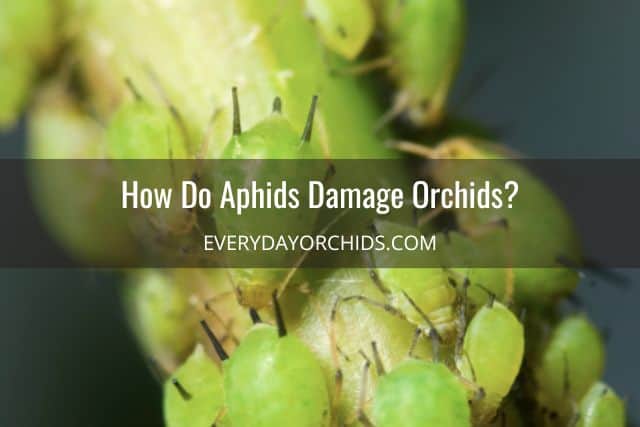
Aphids affect orchids in a number of ways. For starters, these sap-sucking insects cause the orchid leaves to turn yellow and curl inward. Affected leaves may start to soften and droop with severe infestations.
As the aphids eat the nutrients from the orchid, the orchid’s growth then slows and becomes stunted. Overtime, the orchid becomes weaker and more prone to disease and other problems.
If aphids have attacked a flower bud or unbloomed orchid flower, the petals will be mottled and streaked when the flower eventually blooms. That is, if it even blooms. Unfortunately, in most cases, the flower will fail to bloom.
Not only do aphids cause physical damage to the orchid, but they, like most other pests, can spread disease amongst plants. Most notably, aphids can carry viruses. When they pierce the leaves and start sucking sap from the plant, they can transfer viral pathogens to the plant.
On top of all that, aphids secrete honeydew, that sticky, clear substance that you sometimes find on orchid leaves.
Honeydew, in turn, attracts ants and sooty mold, further exacerbating the problem at hand. As a matter of fact, ants love eating that clear sticky honeydew so much that they have learned to farm aphids. When you see aphids on your orchids, be on the lookout for ants, and vice versa.
Identification
Recognizing an aphid is the first step to tackling an aphid infestation problem. Aphids have pear-shaped bodies and are either light-green or black in color. They are fairly small, measuring just a few millimeters in length.
Aphids tend to shed their white outer layer of skin as they grow. These piles of white skin can collect on the orchid leaves and are another sign of an aphid infestation.
Where Do Aphids Hide On Orchids?
When looking for aphids on orchids, you’ll want to check out a few key areas. Aphids tend to hide on the underside of orchid leaves, so look there first.
They also like to hide near the flower buds, on the underside of orchid blooms, and on tender, new growth. These pests can also hide in the crevices and joints of orchid leaves, between the leaf and main stem.
Essentially, you’ll need to be very thorough when checking for aphids on orchids, as these pests are small and have a number of places they like to hide out in.
Life Cycle
When you find one aphid on your orchids, watch out. These pests can reproduce quickly and within a matter of days, you can have a population explosion of aphids on your orchids.
A mature, adult female aphid will give birth to dozens of female nymphs each day for 20 to 30 days. We are talking about up to 100 female nymphs being born a day. Those female nymphs will immediately start to feed on the orchid plant, sucking the nutrients and sap out of the leaves.
Once the nymphs reach maturity, each one of these females will then go on to birth dozens of aphids each day. In just a few days, a plant can become overrun with aphids.
When the aphid colonies become too large and the plant becomes overcrowded with aphids, winged aphids develop.
These winged pests travel to nearby plants and set up a new colony there. The cycle continues. Within a couple of weeks, a few aphids can quickly become a large, widespread infestation encompassing multiple plants.
How To Get Rid Of Aphids On Orchids
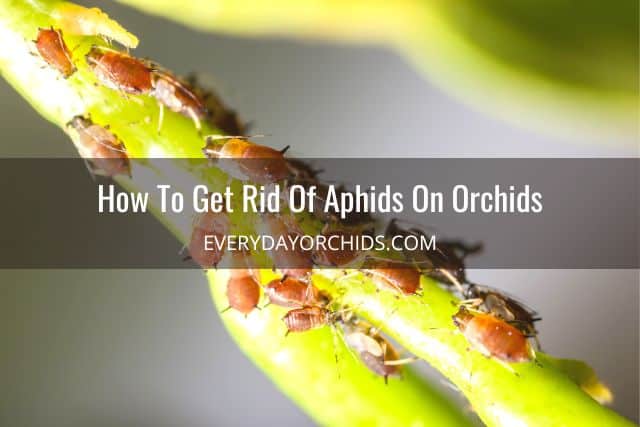
Now that you’ve identified aphids on your orchids, you may be wondering how to get rid of them. Here are some treatment methods you can use, starting with the methods you’d use for small infestations to what you’d do for major aphid infestations.
Treatment Methods: Water Spray
A forceful spray of water will work well if you have just a small aphid infestation on your orchids. This is a quick and easy way to dislodge any aphids clinging to the underside of your orchid leaves.
First, bring your orchids outdoors. If this is not possible, then bring the orchids to the kitchen sink, shower or bathtub.
You’ll want to do this treatment in the morning so that your orchids will have a chance to dry out before nightfall.
Using a strong flow of water, rinse off the orchid. If you are doing this in the kitchen sink, use a pull-down kitchen faucet spray nozzle to wash aphids off your orchid’s leaves.
Thoroughly spray down your orchid and focus on the underside of the leaves and anywhere that aphids may be located. Allow your orchid to dry.
If water got into the orchid’s crown, use a napkin or paper towel to dab up the excess water. This will help prevent crown rot from taking hold. Likewise, if water got between the leaves and the orchid’s main stem, dry that area as well. This will prevent stem rot.
Alternatively, if the weather is good, leave your orchid outdoors for the rest of the day. The breezes and air currents will help dry off any water remaining between the leaves and main stem.
If you do this, put your orchids in an area where they will be exposed to bright, indirect light, but where they will also be protected from direct sunlight. Direct sunlight exposure can burn the orchid leaves and change their color.
Water Spray And Insecticidal Soap Spray Combo
If you have a large number of aphids on your orchid, use a water spray to dislodge the aphids and follow this up with an insecticidal soap spray. I’ll talk about insecticidal soap sprays more in a bit, but this is an effective treatment option for dealing with aphids on orchids.
If you are able to identify the aphid infestation early on, usually a water spray is enough to remove the pests. Be aware that spraying the orchids down once will not be enough to get rid of every single aphid.
After all, it’s very possible that you might have missed one or two aphids, and this is enough to keep the population going. Continue to check on your orchid for the next few days and weeks. Look for any signs of aphids or other orchid pests and deal with it right away.
Treatment Method: Rubbing Alcohol
Rubbing alcohol, or 70% isopropyl alcohol, is one of my favorite go-to methods for dealing with a pest infestation. Take some cotton swabs soaked in rubbing alcohol and use these to dislodge and wipe away the aphids.
I use this method for dealing with mealybugs, scale and spider mites too. It’s a very inexpensive, yet effective, way to get rid of orchid pests.
When using rubbing alcohol and cotton swabs to remove aphids on orchids, focus on the underside of the leaves.
Also look at the joints of the leaves, where the leaf meets the main stem. Aphids may also be hiding in the leaf sheaths and crevices of the orchid. Fortunately, the cotton swab is small enough that you can get in there and remove them.
One treatment will not be enough. You’ll need to do this once a week until all aphids are gone.
Be aware that this simple treatment method of rubbing alcohol and cotton swabs is most effective with smaller, more manageable pest infestations. If you have a large infestation with thousands of aphids, you’ll most likely want to use an insecticide spray or horticultural oil to deal with the problem.
Treatment Method: Horticultural Oils
For aphid infestations of any size, you can use a horticultural oil such as neem oil. Horticultural oils help eliminate pests by smothering them and slowing their movements.
To maximize effectiveness, thoroughly spray all affected areas with the horticultural oil. You will need to prepare the horticultural oil first by mixing it with water and a bit of mild dish detergent. Then pour the solution in a spray bottle equipped with a fine mist spray and spray the orchid.
Neem Oil
Neem oil is a popular horticultural oil used to deal with a variety of orchid pests, including aphids. It works by disrupting the stages of insect development and stopping reproduction. It also smothers any existing pests, slowing their movement and preventing them from moving between plants.
Neem oil is a favorite of many indoor plant growers because it is safe to use around children and pets. It is non-toxic and relatively effective at reducing aphid populations.
You can read more about neem oil on Everyday Orchids. For information about how to prepare, dilute and apply neem oil to orchids, check out this guide to using neem oil on orchids.
Treatment Method: Insecticidal Soap Spray
Another option for dealing with aphids on orchids is to use an insecticidal soap spray.
Examples of this include the Safer brand of insecticidal soap. Similar to horticultural oils, insecticidal soaps work by smothering the pests and dissolving the outer waxy cuticle of the pests’ exoskeleton.
Based on how they work to kill insects, insecticidal soaps are most effective against soft-bodied pests such as mealybugs and aphids. These pests have an outer waxy covering that dissolves with rubbing alcohol or insecticidal soap.
Insecticidal soap sprays are generally safe for orchids, but always check the product label to make sure that it is safe for orchids and will kill aphids. The label may not specifically say “safe for orchids,” but if it says “safe for ornamentals” or “safe for tropical plants,” that generally includes orchids.
When applying insecticidal soap sprays, you’ll need to take caution when spraying young orchids or new growth.
In addition, use this outdoors in a well-ventilated space and wear gloves. I prefer using dishwashing gloves for this. Dishwashing gloves are waterproof and will keep any insecticidal soap from touching your skin.
Always, always test this out in a small area of your orchid first before you start spraying the entire plant.
Treatment Methods: Insecticide
If the aphids are numerous and wide-spread across multiple orchid plants, you may have to resort to chemical methods such as pesticides or insecticides.
If you are going to pull out the big guns and use insecticides on your orchids, always check to make sure that it is safe for orchids first. Orchids are tropical plants and can be more sensitive to the chemicals in insecticides. Even if the product label states “safe for orchids,” I would recommend testing it out on a small area of your orchids first.
In addition, when using insecticides, do this outdoors in a well-ventilated area. Wear gloves and eye protection if needed.
With the exception of Orange Guard, these products contain chemicals. They are not pet or child-friendly. To be safe, keep these out of reach and out of the area that your pets and children may play in.
Here are a few recommended insecticide products you can use on your orchids.
Orange Guard
Orange Guard is an organic insecticide that is safe to use in the home, around children and pets. It is made from orange peels, is water-based and is fully biodegradable. This is great at killing and repelling pests such as ants, so use this if you have a combination aphid/ant problem around your orchids.
BioAdvanced 3-in-1
BioAdvanced 3-in-1 spray is an insecticide, miticide and fungicide all rolled into one spray. The active ingredients include imidacloprid, tau-fluvalinate, and tebuconazole.
While the product label says it can be safely used on ornamental plants, you should test it out in a small area of your orchid first.
Also, this is a concentrated solution. Dilute it according to the product directions before use. Use a spray bottle to apply and do so outdoors in a well-ventilated area.
I would recommend using BioAdvanced 3-in-1 spray if you have multiple issues going on with your orchids, such as aphids and sooty mold. Sooty mold is caused by a fungal infection and is also detrimental to orchids. The BioAdvanced 3-in-1 spray is also effective against other orchid pests, such as spider mites.
Malathion
Malathion is a commercial insecticide that is popular with many plant growers. Commercial insecticides are a last resort type of treatment option. These are most appropriate for dealing with large infestations that may cover multiple plants.
Malathion is not specific to aphids, but it can kill aphids, mosquitos, spider mites, mealybugs and a wide variety of other pests.
OrthoMax malathion insecticide is one such product. It is sold as a concentrate, so must be diluted before use. For safety reasons, you should only use it outdoors. You can use this on ornamental plants, such as orchids (do a small test first!) as well as citrus trees, roses, and other outdoor plants.
Natural Predators
If you keep your orchids outdoors and have aphids on your orchids and other plants, consider using natural predators to deal with the problem. Natural predators of aphids include lacewings, midges, lady beetles and wasps.
You can buy lacewings online or at your local garden center. When buying online, you’ll likely only be able to purchase lacewing eggs. This is fine. Just follow the package instructions. You’ll need to prepare the lacewing egg mixture and put it into small hanging bags (which should be included). Hang the bags in a shaded area near the orchids. Then, simply wait for the lacewings to hatch and eat the aphids.
Treatment Tips For Aphids On Orchids

As with any treatment method for pest control, you will find that one treatment attempt is not enough to kill off all the pests. You will, most likely, have to go back multiple times to fully eliminate the pests.
This is totally normal and does not mean that the pest treatment was ineffective. In many cases, it is impossible to fully eradicate any orchid pest infestation on the first try.
In your first treatment, you are targeting the adult pests and focused on eliminating as many pests as possible. However, there will likely be some stragglers that hide and survive.
Also, as the nymphs grow and eggs hatch and move through the life stages, they will get bigger. As they grow in size, you’ll start to notice these pests as well. Repeated treatments are necessary to account for the different stages in the pests’ life cycle.
Repeat treatments spaced one week apart to allow you to get the stragglers, the growing nymphs and any newly hatched pests.
If one treatment option does not seem very effective, you may need to try another method. Do this until you find one that works. This is also why I provided a variety of treatment options above.
As time goes on and you’ve completed multiple applications or treatments, you should see less and less aphids on your orchids. Eventually, you’ll see no pests. Once this happens, you’ll know that your pest elimination efforts were successful.
All that to say, don’t give up. Dealing with a pest infestation of any kind takes time and repeated effort.
This is also why early identification is so key. The earlier you can identify a pest infestation and the less time they will have to multiply, the easier it is to deal with.
How To Prevent Aphids On Orchids
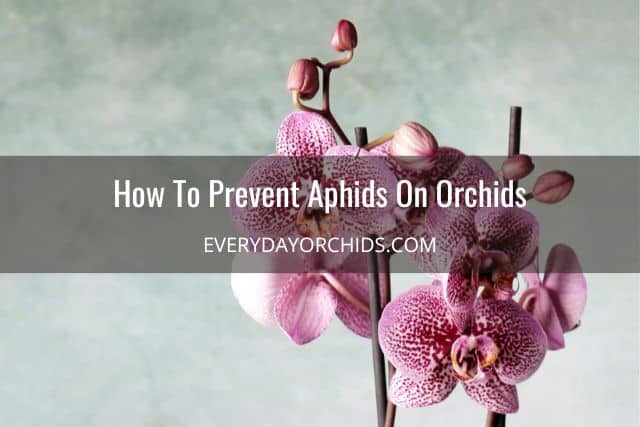
Prevention is important whenever we talk about pest infestations, but especially with aphids.
Once an aphid gets into your plant and starts reproducing, it’s just a matter of time before the population starts to exponentially increase.
Obviously, you’ll want to identify and catch these pests early before the problem gets out of hand. Here are some ways you can prevent pest infestations on orchids.
Regular Inspections
Routine, weekly checks of your orchids can allow you to spot orchid pests early on, saving you lots of time in the long run.
At minimum, I check over my orchids each week when I water them. I make it a point to look under the leaves, in the leaf joints where the leaf meets the main stem, and in the crevices.
If I spot any mealybugs, aphids or other pests, then my first course of action is to use a cotton swab soaked in rubbing alcohol to remove the pests. As mentioned earlier, I’ve found that this is a fast and effective method at getting rid of mealybugs and aphids.
As a bonus, regular inspections of your orchid plants allows you to spot signs of disease or stress early. This allows you to address those problems early on as well.
Isolate Affected Orchids
If you do spot aphids (or any other pests) on your orchids, isolate the affected orchid. Put it somewhere else, away from your other plants.
This simple step will help reduce the chances that pests will spread to other plants. It will keep the infestation isolated to just one plant, making it easier to deal with.
Regular Pruning And Maintenance
Another way to prevent pests on your orchids is to keep your orchids healthy and well-maintained.
Regularly prune your orchids and remove any dead plant material. By doing this, you are removing hiding spots for pests to gather and lay eggs.
Pruning away any dead plant material also helps reduce the chances that your orchid will be exposed to mold, bacteria and other pathogens found in decaying organic material.
Control Aphids On Other Plants
Finally, if you notice aphids infesting your other plants, such as your vegetable garden or roses, take steps to control the aphid infestation there.
Aphid infestations amongst outdoor plants are a concern if you keep your orchids outdoors. These orchids will be at higher risk for infestations from winged pests and insects than indoor orchids.
If you have aphids in a vegetable garden or on your other outdoor plants, take steps to eliminate them. Left to their own devices, the aphid population will grow and become overly crowded.
Once the colony is overcrowded, some aphids will develop wings. They will then migrate to nearby plants and form new colonies. The risk is that they may migrate over to your orchid plants and infest your orchids.
There are a variety of ways you can manage the aphid infestation on your other plants.
Use some of the methods outlined above, such as using neem oil sprays or insecticidal soaps. If you are new to neem oil, you can read about how to dilute and apply neem oil on orchids here. For non-edible plants or for wide-spread aphid infestations, you may even opt for insecticides containing Malathion.
In addition, placing yellow sticky traps around aphid-infested plants can also be effective at capturing some winged aphids. While this won’t do much for bringing down the population or stopping reproduction, it will at least prevent some of the winged aphids from flying off and infesting nearby plants. Use yellow sticky traps in conjunction with any of the other treatment methods above to prevent aphids from affecting your orchids.
Final Thoughts
A pest infestation on your orchids can be stress-inducing and time-consuming to deal with. Aphid infestations are no exception. Aphids on orchids damage the leaves and weaken the orchid. Left alone, aphid infestations can kill an orchid plant over time.
Fortunately, there are a variety of ways you can eradicate aphids from your orchids, including rubbing alcohol, insecticidal soap spray, and pesticides.
Early detection and intervention are key once you spot an aphids on your orchids. Once you’ve dealt with the problem and eliminated the aphids, follow my tips above to prevent them from coming back. Good luck!
